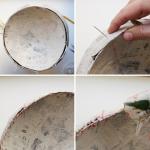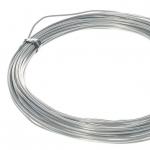INTERSTATE STANDARD
LOW CARBON WIRE
COLD DRAWN STEEL
FOR REINFORCEMENT OF REINFORCED CONCRETE
CONSTRUCTIONS
TECHNICAL CONDITIONS
IPC PUBLISHING HOUSE OF STANDARDS
Moscow
INTERSTATE STANDARD
Date of introduction 01/01/83
This standard applies to cold-drawn low-carbon steel wire of periodic profile class VR-1 for reinforcement reinforced concrete structures.
1. MAIN PARAMETERS AND DIMENSIONS
1.1. (Deleted, Amendment No. 3).
1.2. The main parameters and dimensions of the wire must correspond to those indicated in the table. 1.
Wire size designations are shown in the drawing.
Table 1
Note: Nominal pitch of dents s and radius of mating surface of dents with protrusions R are reference values for the design of a profiling tool and are not tested on wire.
(Changed edition, Amendment No. 2, 3).
1.3. Radius of interface between the surface of dents and protrusions R for wire of all diameters should be equal to (2.5 ± 0.5) mm.
Relative displacement of opposite dents is allowed up to 0.5 S and their location along the helical line of the wire axis.
1.4. Size difference A And A 1 must not exceed the size tolerance range A.
An example of a symbol for wire with a nominal diameter of 3.0 mm:
2. TECHNICAL REQUIREMENTS
2.1. The wire must be manufactured in accordance with the requirements of this standard according to technological regulations approved in the prescribed manner. The wire must be made from wire rod in accordance with OST 14-15-193.
(Changed edition, Amendment No. 1, 2).
2.2. The mechanical properties of the wire must correspond to those indicated in the table. 2.
table 2
2.3. There should be no cracks, caps, sunsets, or shells on the surface of the wire.
Risks and scratches with a depth of no more than half are allowed maximum deviations per size A and a coating of rust.
(Changed edition, Amendment No. 3).
2.4. The wire is produced in coils weighing 500-1500 kg. It is allowed to produce wire in coils weighing 20-100 kg. Each skein should consist of one piece of wire. The wire should be rolled into skeins in untangled rows.
(Changed edition, Amendment No. 2).
2.5. Linear density wire must correspond to that indicated in the table. 3.
Table 3
The calculated cross-sectional area and theoretical linear density of the wire are given in Appendix 2.
(Changed edition, Amendment No. 2, 3).
3. ACCEPTANCE RULES
3.1. Wire is accepted in batches. The batch must consist of wire, documented in one quality document, which should indicate:
Test results;
Number of skeins;
Batch number;
Net weight of the party;
(Changed edition, Amendment No. 1, 2, 3).
3.2. Size A, size difference A And A 1 and the quality of the wire surface is checked on each skein.
(Changed edition, Amendment No. 3).
3.3. To check the mechanical properties of the wire and the parameters of the wire profile, 3% of the coils must be selected from the batch, but not less than 5 coils.
(Changed edition, Amendment No. 2).
3.4. If unsatisfactory test results are obtained for at least one of the indicators, repeated tests are carried out on a double sample. The results of the re-inspection are applied to the entire batch.
4. TEST METHODS
4.1. For each type of test, one sample is taken from one end of the skein.
4.2. The quality of the wire surface is controlled by the naked eye.
4.3. Dimensions A And A 1 wire is measured with a micrometer according to GOST 6507.
Amount of size difference A And A 1 is defined as the arithmetic mean of three measurements taken over an area 1 m long.
(Changed edition, Amendment No. 2, 3).
4.4. The wire profile parameters are determined as the arithmetic mean of three measurements taken over a section 1 m long on each side.
Dent depth h measured with a micrometer in accordance with GOST 6507, equipped with a special heel (mandatory appendix 1).
Length of projection b measured by a reading microscope MPB-2, manufactured according to technical documentation.
In case of disagreement in the measurement of wire profile parameters, control is carried out according to the linear density of the wire (Table 3).
The linear density of the wire is determined as the quotient of the mass of two samples 1 m long, weighed with an error of up to 0.001 kg, divided by their length, measured with an error of up to 0.001 m.
(Changed edition, Amendment No. 2, 3).
4.5. Wire tensile testing is carried out according to GOST 12004.
4.6. Wire bend testing is carried out according to GOST 1579. Wire with a diameter of 3.0 and 4.0 mm is tested on rollers with a diameter of 20 mm, and with a diameter of 5.0 mm - on rollers with a diameter of 30 mm.
When testing a wire, the sample is clamped so that the dents face the jaws of the device.
4.5, 4.6 (Changed edition, Amendment No. 2).
4.7. The depth of marks and scratches is determined by removing them by sanding, followed by comparative measurements in cleaned and uncleaned areas.
(Changed edition, Amendment No. 2, 3).
5. PACKAGING, LABELING, TRANSPORTATION AND STORAGE
5.1. Each skein weighing 500-1500 kg must be evenly tied around the circumference in at least four places, and a skein weighing 20-100 kg - in at least three places.
At the consumer's request, a skein weighing 500-1500 kg must have intermediate knittings located inside the skein.
Wire rod in accordance with OST 14-15-193 or heat-treated wire in accordance with regulatory and technical documentation will be used as binding materials.
The ends of the skein should be neatly laid out and easily found.
(Changed edition, Amendment No. 2, 4).
5.1a. Rolls of wire weighing 20-100 kg are tied into coils.
The weight of the cargo package should not exceed 1500 kg. By agreement between the manufacturer and the consumer, an increase in the weight of the cargo package is allowed.
Cargo packages are formed into transport packages in accordance with GOST 24597 and GOST 21650.
5.2. Each skein (coil) must have a label firmly attached to it, indicating:
Trademark or name and trademark of the manufacturer;
Wire symbol;
Batch number;
Technical control mark;
Image of the state quality mark for wire of the highest quality category.
(Changed edition, Amendment No. 1, 2).
5.3. Wire is transported by all types of transport in accordance with the rules for the carriage of goods in force for this type of transport. Placing and securing cargo in vehicles, transported by railway, should match technical specifications loading and securing of cargo, approved by the Ministry of Railways of the USSR. Transportation by rail is carried out by wagonload and low-tonnage or small shipments.
It is allowed to transport wire in universal containers in accordance with GOST 15102, GOST 20435, GOST 22225.
5.4. Wire storage is according to the conditions of 5 GOST 15150.
5.3, 5.4. (Changed edition, Amendment No. 2).
5.5. Transportation of wire sent to the regions of the Far North and areas equivalent to them is carried out in accordance with GOST 15846.
(Changed edition, Amendment No. 3).
5.6. Transport marking - according to GOST 14192.
(Introduced additionally, Amendment No. 2).
ANNEX 1
Mandatory
Special heel for micrometer type MK according to GOST 6507 for measuring the depth of dents

Material - steel ШХ15, У10А, У12А.
Hardness - НRC48-50
APPENDIX 2
Information
Calculated cross-sectional area and theoretical linear density of wire
APPENDIX 2. (Changed edition, Amendment No. 2, 3).
INFORMATION DATA
1. DEVELOPED AND INTRODUCED by the Ministry of Ferrous Metallurgy of the USSR
DEVELOPERS
EAT. Kireev, K.G. Zalyalutdinov, Kh.N. Belalov, N.A. Galkina, T.A. Korshunova, K.V. Mikhailov, V.I. Bondarenko, V.M. Skubko
2. APPROVED AND ENTERED INTO EFFECT by Resolution of the USSR State Committee on Standards dated May 15, 1980 No. 2108
3. INSTEAD GOST 6727-53
4. REFERENCE REGULATIVE AND TECHNICAL DOCUMENTS
5. The validity period was lifted according to Protocol 2-93 of the Interstate Council for Standardization, Metrology and Certification (IUS 2-93)
6. EDITION (May 2003) with Amendments No. 1, 2, 3, 4, approved in December 1984, June 1987, October 1988, February 1990 (IUS 3-85, 10-87 , 1-89, 5-90)
___________________________________________________________________________________________________________________________
Reissue(as of April 2008)
GOST 6727-80
Group B71
INTERSTATE STANDARD
COLD-DRAWN LOW CARBON STEEL WIRE FOR REINFORCEMENT OF REINFORCED CONCRETE STRUCTURES
Specifications
Cold-drawn low-carbon steel wire for reinforced concrete. Specifications
MKS 77.140.65
OKP 12 1400
Date of introduction 1983-01-01
INFORMATION DATA
1. DEVELOPED AND INTRODUCED by the USSR Ministry of Ferrous Metallurgy
DEVELOPERS
E.M.Kireev, K.G.Zalyalyutdinov, Kh.N.Belalov, N.A.Galkina, T.A.Korshunova, K.V.Mikhailov, V.I.Bondarenko, V.M.Skubko
2. APPROVED AND ENTERED INTO EFFECT by Resolution of the USSR State Committee on Standards dated 05.15.80 N 2108
3. INSTEAD GOST 6727-53
4. REFERENCE REGULATIVE AND TECHNICAL DOCUMENTS
Number of paragraph, subparagraph, application |
|
4.3, 4.4, Appendix 1 |
|
OST 14-15-193-86 |
5. The validity period was lifted according to Protocol 2-93 of the Interstate Council for Standardization, Metrology and Certification (IUS 2-93)
6. EDITION (May 2003) with Amendments No. 1, 2, 3, 4, approved in December 1984, June 1987, October 1988, February 1990 (IUS 3-85, 10-87 , 1-89, 5-90)
Reprint (as of April 2008)
This standard applies to cold-drawn low-carbon steel wire of periodic profile of class VR-1 for reinforcement of reinforced concrete structures.
1. MAIN PARAMETERS AND DIMENSIONS
1.1. (Deleted, Amendment No. 3).
1.2. The main parameters and dimensions of the wire must correspond to those indicated in Table 1.
Wire size designations are shown in the drawing.
Table 1
Nomi- | Nominal size | Limit deviations | Dent depth | Limit deviations | Nominal pitch of dents | Limit deviations | Length of projection | Limit deviations |
0,03 | 0,05 | |||||||
0,04 | ||||||||
Note. Nominal dent pitch
and the radius of the interface between the surface of the dents and the protrusions are reference values for the design of a profiling tool and are not checked on the wire.
(Changed edition, Amendment No. 2, 3).
1.3. The radius of the interface between the surface of the dents and the protrusions for wire of all diameters should be equal to (2.5 ± 0.5) mm.
A relative displacement of opposite dents of up to 0.5 and their location along the helical line of the wire axis is allowed.
1.4. The difference in size must not exceed the size tolerance range.
An example of a symbol for wire with a nominal diameter of 3.0 mm:
Wire 3 VR-1 GOST 6727-80.
2. TECHNICAL REQUIREMENTS
2.1. The wire must be manufactured in accordance with the requirements of this standard according to technological regulations approved in the prescribed manner.
The wire is made from wire rod according to OST 14-15-193.
2.2. The mechanical properties of the wire must correspond to those indicated in Table 2.
table 2
Breaking force , gN (kgf) | Force corresponding to the conditional yield strength, gN (kgf) | Number | Relative extension , % |
||
no less |
|||||
(Changed edition, Amendment No. 1, 3).
2.3. There should be no cracks, caps, sunsets, or shells on the surface of the wire.
Risks and scratches with a depth of no more than half the maximum deviations for size and rust are allowed.
(Changed edition, Amendment No. 3).
2.4. The wire is produced in coils weighing 500-1500 kg. It is allowed to produce wire in coils weighing 20-100 kg. Each skein should consist of one piece of wire. The wire should be rolled into skeins in untangled rows.
(Changed edition, Amendment No. 2).
2.5. The linear density of the wire must correspond to that indicated in Table 3.
Table 3
Nominal diameter wire, mm | Linear density, kg, no more |
The calculated cross-sectional area and theoretical linear density of the wire are given in Appendix 2.
(Changed edition, Amendment No. 2, 3).
3. ACCEPTANCE RULES
3.1. Wire is accepted in batches. The batch must consist of wire of the same diameter, drawn up in one quality document, which should indicate:
- test results;
- number of skeins;
- batch number;
- net weight of the batch;
(Changed edition, Amendment No. 1, 2, 3).
3.2. The size, size difference and surface quality of the wire are checked on each skein.
(Changed edition, Amendment No. 3).
3.3. To check the mechanical properties of the wire and the parameters of the wire profile, 3% of the coils must be selected from the batch, but not less than 5 coils.
(Changed edition, Amendment No. 2).
3.4. If unsatisfactory test results are obtained for at least one of the indicators, repeated tests are carried out on a double sample. The results of the re-inspection are applied to the entire batch.
4. TEST METHODS
4.1. For each type of test, one sample is taken from one end of the skein.
4.2. The quality of the wire surface is controlled by the naked eye.
4.3. Dimensions and wires are measured with a micrometer according to GOST 6507.
The magnitude of the difference in size is determined as the arithmetic mean of three measurements taken over a section 1 m long.
(Changed edition, Amendment No. 2, 3).
4.4. The wire profile parameters are determined as the arithmetic mean of three measurements taken over a section 1 m long on each side.
The depth of the dents is measured with a micrometer in accordance with GOST 6507, equipped with a special heel (Appendix 1).
The length of the protrusion is measured by a reading microscope MPB-2, manufactured according to technical documentation.
In case of disagreement in the measurement of wire profile parameters, control is carried out according to the linear density of the wire (Table 3).
The linear density of the wire is determined as the quotient of the mass of two samples 1 m long, weighed with an error of up to 0.001 kg, divided by their length, measured with an error of up to 0.001 m.
(Changed edition, Amendment No. 2, 3).
4.5. Wire tensile testing is carried out according to GOST 12004.
4.6. Wire bend testing is carried out according to GOST 1579. Wire with a diameter of 3.0 and 4.0 mm is tested on rollers with a diameter of 20 mm, and with a diameter of 5.0 mm - on rollers with a diameter of 30 mm.
When testing a wire, the sample is clamped so that the dents face the jaws of the device.
4.5, 4.6. (Changed edition, Amendment No. 2).
4.7. The depth of marks and scratches is determined by removing them by sanding, followed by comparative measurements in cleaned and uncleaned areas.
(Changed edition, Amendment No. 2, 3).
5. PACKAGING, LABELING, TRANSPORTATION AND STORAGE
5.1. Each skein weighing 500-1500 kg must be evenly tied around the circumference in at least four places, and a skein weighing 20-100 kg - in at least three places.
At the consumer's request, a skein weighing 500-1500 kg must have intermediate knittings located inside the skein.
Wire rod according to OST 14-15-193 or heat-treated wire according to regulatory and technical documentation is used as binding materials.
The ends of the skein should be neatly laid out and easily found.
(Changed edition, Amendment No. 2, 4).
5.1a. Rolls of wire weighing 20-100 kg are tied into coils.
The weight of the cargo package should not exceed 1500 kg. By agreement between the manufacturer and the consumer, an increase in the weight of the cargo package is allowed.
Cargo packages are formed into transport packages in accordance with GOST 24597 and GOST 21650.
5.2. Each skein (coil) must have a label firmly attached to it, indicating:
- trademark or name and trademark of the manufacturer;
- symbol wires;
- batch number;
- technical control mark;
- image of the state Quality Mark for wire of the highest quality category.
(Changed edition, Amendment No. 1, 2).
5.3. Wire is transported by all types of transport in accordance with the rules for the carriage of goods in force for this type of transport. The placement and securing of cargo in vehicles transported by rail must comply with the technical conditions for loading and securing cargo approved by the USSR Ministry of Railways. Transportation by rail is carried out by wagonload and low-tonnage or small shipments.
It is allowed to transport wire in universal containers in accordance with GOST 15102, GOST 20435,
(Introduced additionally, Amendment No. 2).
APPENDIX 1 (mandatory). Special heel for micrometer type MK according to GOST 6507 for measuring the depth of dents
ANNEX 1
Mandatory
Material - steel ШХ15, У10А, У12А. Hardness - HRC48-50.
APPENDIX 2 (for reference). Calculated cross-sectional area and theoretical linear density of wire
APPENDIX 2
Information
Nominal wire diameter, mm | Design cross-sectional area, mm | Theoretical linear density, kg* |
0.052 the following is explained: in Appendix 2, namely the header of the table, there was a typo - Theoretical linear density is measured in kg/m. - Database manufacturer's note. |
GOST 6727-80
INTERSTATE STANDARD
COLD-DRAWN LOW CARBON STEEL WIRE FOR REINFORCEMENT OF REINFORCED CONCRETE
CONSTRUCTIONS
TECHNICAL CONDITIONS
Official publication
IPC PUBLISHING HOUSE OF STANDARDS Moscow
INTERSTATE STANDARD
COLD-DRAWN LOW CARBON STEEL WIRE FOR REINFORCEMENT OF REINFORCED CONCRETE STRUCTURES
Specifications
Cold-drawn low-carbon steel wire for reinforced concrete. Specifications
MKC 77.140.65 OKP 12 1400
Date of introduction 01/01/83
This standard applies to cold-drawn low-carbon steel wire of periodic profile of class VR-1 for reinforcement of reinforced concrete structures.
1. MAIN PARAMETERS AND DIMENSIONS
1.1. (Deleted, Amendment No. 3).
1.2. The main parameters and dimensions of the wire must correspond to those indicated in the table. 1. Wire size designations are shown in the drawing.




